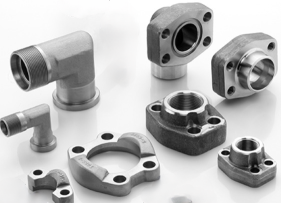Hydraulic systems are the unsung heroes behind many of the machines and equipment that power our modern world. Hydraulic systems are crucial in transmitting power efficiently. They are used in construction machinery and aerospace applications.
SAE flanges are essential components that enable hydraulic fluids to flow seamlessly. They lie at the heart of these systems. In this article, we will explore SAE flanges. We will decode their standards and understand their important role in hydraulic connectivity.
Understanding SAE Flanges
Defining SAE Flanges
SAE flanges connect and seal parts of a hydraulic system. They are hydraulic fittings. They are known for their efficiency, leak-free performance, and robustness. Flanges ensure smooth operation of hydraulic systems, no fluid or pressure loss.
History and Development
SAE flanges have a long history that started in the mid-20th century. Hydraulic systems were becoming important in many industries at that time. The development of these flanges was crucial. It standardized hydraulic connections. It ensured compatibility across different components and manufacturers.
Types of SAE Flanges
➡️ SAE Code 61 Flanges
SAE Code 61 flanges are designed for lower pressure applications, typically up to 3,000 psi. They are known for their simplicity and ease of assembly. These flanges are widely used in applications like agriculture and construction equipment.
➡️ SAE Code 62 Flanges
SAE Code 62 flanges are built to handle higher pressures, typically ranging from 3,000 to 6,000 psi. They offer a secure connection with no leaks. This makes them perfect for demanding applications like industrial machinery. They are also great for heavy equipment.
➡️ SAE Split Flanges
SAE split flanges are versatile. They provide a practical solution for retrofitting or repairing hydraulic connections. Code 61 and Code 62 configurations are available, meeting various pressure needs.
Differences and Applications
It is crucial to understand the distinctions between these SAE flanges. This understanding will help in selecting the right one for a specific application. Pressure ratings, assembly methods, and application requirements affect flange choice. The choice is between SAE Code 61 and SAE Code 62 flanges.
SAE Flange Standards
➡️ SAE J518 Standard
The SAE J518 standard is also called the Code 61 standard. It describes the design and performance specifications for 4-bolt flanges. These flanges are used in hydraulic systems. Manufacturers rely on this standard. It ensures safety and reliability of SAE Code 61 flanges. The standard sets the necessary criteria for operation.
➡️ ISO 6162 Standard
The ISO 6162 standard is also known as the Code 62 standard. It is an international standard that aligns with SAE Code 62 flanges. These flanges can be used worldwide, ensuring global compatibility. They are a universal choice for high-pressure hydraulic systems.
The Anatomy of SAE Flanges
➡️ Flange Head and Socket
SAE flanges consist of two main components: the flange head and the socket. The flange head has four or more bolt holes for secure attachment. The socket has a recess for the O-ring and the pipe or tube.
➡️ Counterbore and Bore
The counterbore, which surrounds the bolt holes on the flange head, holds the O-ring in place. The socket side has a bore that accommodates the pipe or tube end. This creates a leak-free seal when the flanges are connected.
➡️ Port Threads and Size
SAE flanges have port threads to securely connect with other components. The size of the components must match for a proper fit. The threading of the components must also match for a proper fit.
➡️ O-Ring Groove and Material
The O-ring groove houses the O-ring, which is a crucial element for creating a reliable seal. The O-ring is typically made of NBR or other compatible elastomers.
Installation and Maintenance
➡️ Proper Assembly Techniques
Proper assembly of SAE flanges is critical for ensuring their leak-free performance. It is essential to follow assembly techniques, torque specifications, and tightening sequences. These ensure successful operation.
➡️ Inspection and Leak Prevention
Regular inspection and maintenance are necessary to prevent leaks. This will ensure the continued performance of SAE flanges. This includes checking O-rings, bolts, and the overall condition of the flanges.
➡️ Maintenance Best Practices
Routine maintenance should include inspections, cleaning, and the replacement of O-rings as needed. Following best practices for maintenance ensures the long-term reliability of SAE flanges. These flanges are important in hydraulic systems.
Challenges and Troubleshooting
➡️ Common Issues with SAE Flanges
SAE flanges are reliable, but they can face challenges. These challenges include O-ring wear, bolt tightening issues, and contamination. Effectively addressing these frequent issues begins with identifying them.
➡️ Effective Troubleshooting Strategies
Having troubleshooting strategies in place can minimize downtime during issues. These strategies also prevent potential damage to hydraulic systems. Troubleshooting should encompass O-ring replacement, bolt retightening, and thorough inspections.
Conclusion
➡️ The Enduring Importance of SAE Flanges
SAE flanges have been essential in hydraulic systems for many years. Their importance in these systems only continues to increase. They are robust, leak-free, and adhere to international standards. They ensure seamless connectivity of hydraulic components.
➡️ How SAE Flanges Shape Hydraulic Connectivity
The versatility and reliability of SAE flanges make them indispensable in various industries. They have a crucial role in shaping hydraulic connectivity. They enable efficient power transfer, ensuring smooth and safe operation. Hydraulic systems are advancing. SAE flanges are also advancing. SAE flanges adapt to modern applications. SAE flanges maintain efficiency and dependability.
We have decoded the standards of SAE flanges in this article. These flanges play a critical role in hydraulic connectivity. They are enduringly important in an ever-evolving industrial landscape.
Post time: Dec-07-2023


